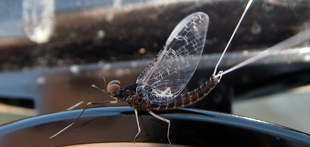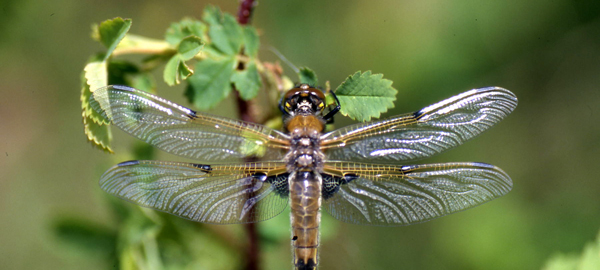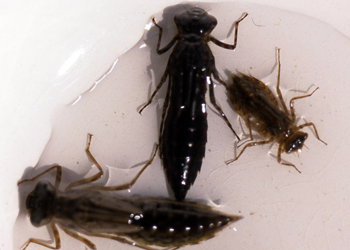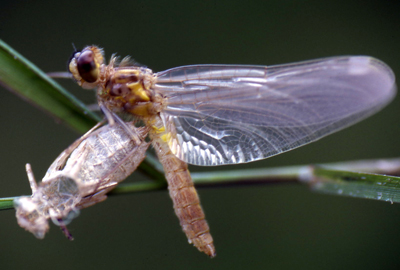|
|
|
Hatches - DragonfliesAquatic insects lead relatively structured lives in that they have a pre-determined life span which is made up of specific developmental stages. Water temperature plays a large part in determining the relative duration of each stage and also when the final emergence into the adult phase is to be completed. Water temperature also determines the sequence of the various aquatic insect emergences or hatches. In stillwaters, the first major emergences of the year are always midges followed by mayflies, damselflies, Caddisflies, and finally dragonflies. Some say the best is saved for last and with dragonflies, certainly the biggest food item is the last major aquatic insect to emerge during a typical stillwater year. The ease of hunting down this large prey more that compensates for the short emergence window as compared to other aquatic insects. Anglers and trout await with much anticipation for these annual nymphal emergence migrations.
Dragonflies belong to the insect order Odonata, suborder Anisoptera. They are closely related to damselflies who are also Odonates but in the suborder Zygoptera. There are almost 500 species of dragonflies and damselflies inhabiting North American lakes, ponds and the slower moving sections of rivers. Worldwide, dragonflies reach their greatest diversity and abundance in the tropics.
Dragonflies and damselflies are easily distinguishable in both nymphal and adult forms. Dragonfly nymphs are almost hour glass shaped and very robust. Damselfly nymphs are very slender and have 3 very distinct paddle shaped caudal lamellae or gills at the tip of their abdomens. Damselfly adults are again slender and, when at rest, lay their wings parallel along their abdomen whereas dragonfly wings are always extended out like airplane wings.
Dragonflies undergo an incomplete metamorphosis or life cycle that includes egg, larval or nymphal stage and the adult form. Developing nymphs undergo numerous molts, shedding their exoskeleton to accommodate the increased body size. In some tropical species, mature nymphs can reach almost 3 inches in length. One of the main reasons dragonflies are such an important trout food source is because of their lengthy nymphal stage as compared to almost all other aquatic insects. Nymphs of some families of dragonflies are 4 years old before emerging into the adult stage. This provides a year round supply of various sized nymphs for foraging trout.
Ideal nymphal habitat is the green plant life and woody debris that grows or accumulates within the littoral or shallow water areas of a lake or nutrient rich stream. This is also excellent habitat for the food that these nymphs feed on which in a nut shell is almost anything that moves that they can get their jaws around. High on their menu are zooplankton, scuds, mayfly nymphs, midge larvae, damselfly nymphs and even small fish. Dragonfly nymphs have an articulated lower jaw that can be extended to grasp and retrieve prey.
The various families of dragonflies are identified or categorized by their nymphal life styles. Crawlers are active predators. They hunt down their prey by constantly moving through the vegetation and other bottom debris or taking short swimming bursts in pursuit of their next meal.
These nymphs are long and slender and because of their feeding styles are more exposed to other predators like trout. Members of the Family Aeshnidae or Darner dragonflies make up the majority of this group and their nymphs can reach almost 2 ½ inches long. Sprawler nymphs are typically very short and flattened in appearance. Mature nymphs can reach about 1 ¼ inches long. The most common sprawler family are the Libellulidae or mud dwellers. Their bodies are typically covered with hair which collects debris and algae that provides further camouflage. They are ambush predators, often hiding or burying themselves in the bottom substrate where they wait for an unsuspecting victim to swim or crawl by within striking range of their jaws. The third category is the burrowers and, as the name implies, these nymphs prefer to bury themselves into the silty bottom or marl areas of a lake or in the backwaters or side channels of a slow moving stream. Burrowers are also sit and attack predators. Members of the Family Gomphidae or Gomphus dragonfly nymphs are a common burrower found in productive stillwaters. Burrower nymphs are short and squat in appearance and reach just over 1 inch long.
All dragonfly nymphs can swim by utilizing a water jet propulsion type system that takes in and forces water out of a chamber located at the end of their abdomen. This system allows nymphs to take 1-3 inch long burst swims to either capture food or avoid being eaten themselves. Dragonfly nymphs are found in a variety of colours ranging from black to various shades of green. The nymphs are able to match the colouration of the habitat they are living in except when just completing a molt. At this time their newly exposed exoskeleton is often several shades lighter than what they just emerged from.
Dragonfly emergences generally occur from late spring until late summer. Often, the most intense emergence activity is concentrated within a 10-14 day period with only minor emergences before or after this time period. This is definitely one hatch that offers lots of visual clues to the observant angler. Fully developed or mature nymphs crawl or take short swimming bursts along the lake bottom towards the shoreline of the lake or stream. They then crawl completely out of the water up onto the stems of riparian vegetation. The adult dragonfly emerges from a crack that develops along the back of the thorax area of the now dried out exoskeleton. Several hours may pass before the transformation to the adult stage is complete. Mating generally occurs within a few days after emergence. Adults can live from several weeks to months and are effective in controlling adult mosquito populations.
Angling Strategies
During peak emergences there will literally be thousands of nymphs crawling out of the water. Anglers should take the time to look at the shoreline vegetation and the ground along the edge of the lake as the nymphs or emerging adults are very visible. Make a note in your fishing diary of this event so that you know general timing for future years. Birds, frogs and snakes quickly cash in on the easy food source. Trout make easy meals of the armies of nymphs as they are heading towards shore. Nymphs will start their shoreward migrations from water as deep as 30 feet although the majority will be crawling along the bottom in water from about 20 feet deep and less. Dragonfly nymph patterns need to be presented as close to the lake bottom as possible, even during non-emergence times because that is where they reside. In the majority of situations this requires the use of sinking fly lines matched to the depth zone to be fished. Therefore slow to high density full sinking and sinking tip lines are all applicable in imitating this emergence movement.
Regardless of the fly line used, you must employ a countdown to determine where your fly is in relationship to the lake bottom. Sinking rates in inches/second are listed on the fly line box and a quick calculation will tell you how many seconds it will take to get the fly line down 15 or 20 feet. Occasionally, snagging the bottom on a retrieve is OK in this situation as it tells you the fly is in the right zone. Some anglers splice 2-3 feet of floating fly line to the end of a sinking line to make a mini "floating tip". This helps keep flies just off the lake bottom and in full view of cruising trout. Dragonfly nymphs move slowly, climbing over and under bottom substrate or as they take short swimming spurts on their shoreward march. Short, but slow, one to three inch strips or hand twist retrieves work well in combination with the occasional faster 3-5 inch strip to imitate some swimming motion. It's also best to anchor your fishing craft so that casts are placed out to the deeper shoal water and retrieved shoreward in the same direction as the nymphs are travelling.
Leaders should not be longer than 7 feet long as you want the fly to stay close to the lake bottom. Floating nymph patterns made from spun deer hair or foam sheeting can be very effective and these can be fished on leaders as short as 3 feet in length. There may be occasions where the trout are feeding heavily on the nymphs in very shallow water, say perhaps less than 10 feet deep. A floating line and a leader of at least 18 feet long can be effective in these, often clear, water situations. The fly is allowed to sink close to the bottom and then a continuous retrieve of short strips is employed.
Windy days sometimes forces adult dragonflies onto the water and they become an opportunistic meal for a passing trout, therefore one or two representative adult patterns should be tucked away in your arsenal of fly boxes. Adult patterns are often best presented with a hard landing on the water which will more easily heard or seen by a nearby trout.
Anglers should keep in mind that dragonfly nymphs are "bread and butter" trout food source as they are available throughout the year. They are always a good searching pattern whether trying to figure out a new piece of water, fishing at night on the shoal areas of lakes during those hot summer periods or during those last few weeks of the fishing season prior to the arrival of winter.
|
|
|
STILLWATER SEMINARS * GUIDING * HOSTED TRIPS
HATCHES:::Dragonflies
|
|
|||||
 |
|
 |
|||
|
|







